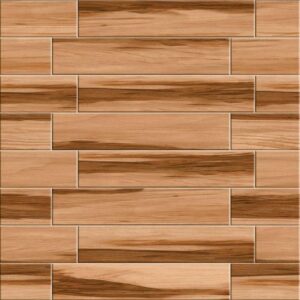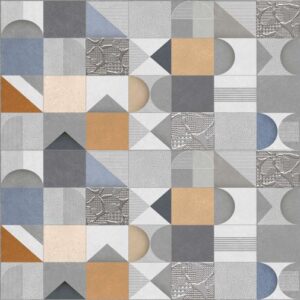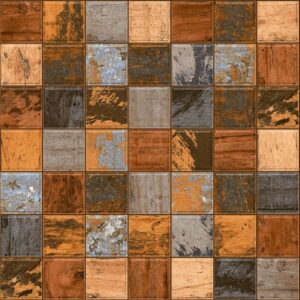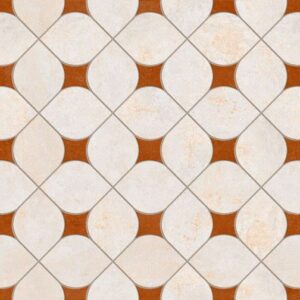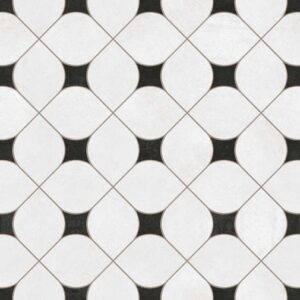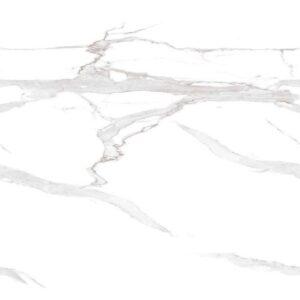PORCELAIN TILE
Thousands of homeowners, builders, and constructors choose porcelain tiles for their homes, offices, and outdoor spaces all over the world, making them one of the most popular flooring materials. Compared to regular ceramics, which are already very durable, porcelain is a form of ceramic tile that is stronger, tougher, and even more water-resistant.
This is accomplished by employing finer-particle clays that are burnt at a higher temperature to provide a tougher, less porous surface than is possible with regular ceramic tiles.
Types of Porcelain Tiles
Glazed Porcelain Tiles:
Features a glass-like coating that adds shine and protects the tile surface. Available in glossy, matte, and textured finishes.
Unglazed Porcelain Tiles:
No additional layer on the surface, offering a natural, matte look.
Generally more slip-resistant than glazed tiles.
Polished Porcelain Tiles:
Polished to a high gloss finish, giving it a sleek, elegant appearance. Suitable for walls and low-traffic areas due to its smooth surface.
Full-Body Porcelain Tiles:
The color and pattern run through the entire thickness of the tile.
More resistant to wear and suitable for high-traffic areas.
Design Ideas for Porcelain Tiles
Wood Look Porcelain Tiles:
Mimics the appearance of natural wood while offering the durability of porcelain. Creates a warm, cozy feel perfect for floors and walls.
Marble Look Porcelain Tiles:
Imitates the luxurious look of marble without the high cost and maintenance. Ideal for elegant, sophisticated bathroom designs.
Stone Look Porcelain Tiles:
Replicates the texture and appearance of natural stone like slate, travertine, or granite. Adds a rustic or contemporary touch to the bathroom.
Large Format Tiles Tiles:
Reduces the number of grout lines, creating a seamless, modern look. Suitable for both walls and floors, making small spaces appear larger.
Patterned Porcelain Tiles:
Offers intricate designs and patterns, adding visual interest to the bathroom. Great for feature walls, backsplashes, or floors.
Porcelain tiles are a versatile and durable choice for bathrooms, offering a wide range of styles to suit any design preference.
WOOD LOOK PORCELAIN TILES
Wood look porcelain tiles are an excellent choice for achieving the aesthetic appeal of natural wood with the practical benefits of porcelain. They are suitable for both floors and walls and can transform a bathroom into a warm, inviting space. Here’s a detailed look at wood look porcelain tiles.
Realistic Appearance:
Mimics the look and texture of natural wood, including grain patterns, knots, and color variations.
Durability:
Highly resistant to wear, scratches, and stains, making them ideal for high-traffic areas.
Water Resistance:
Non-porous and water-resistant, suitable for bathrooms and other wet areas.
Low Maintenance:
Easy to clean and maintain, unlike natural wood which requires sealing and special care.
Versatility:
Available in various sizes, colors, and finishes to match different design styles.
Design Ideas for Wood Look Porcelain Tiles in Bathrooms
Flooring:
Create a cozy, rustic feel by using wood-look tiles on the bathroom floor.
Opt for wide planks for a contemporary look or narrow planks for a traditional feel.
Shower Walls Tiles:
Use wood-look tiles to cover shower walls, adding warmth and texture to the space. Combine with neutral or white tiles for a balanced design.
Accent Walls Tiles:
Feature a wood-look tile accent wall to add depth and interest to the bathroom. Ideal behind the vanity, bathtub, or as a focal point in the shower.
Backsplash Tiles:
Install wood-look tiles as a backsplash behind the sink for a stylish, rustic touch.
Ceiling Tiles:
Extend the wood-look tiles to the ceiling for a unique, enveloping effect. Popular Wood-Look Porcelain Tile Styles
Rustic Oak Tiles:
Features deep grain patterns and a weathered look, perfect for a farmhouse or rustic design.
Walnut Tiles:
Offers rich, dark tones with fine grain, adding elegance to any bathroom.
Whitewashed Wood Tiles:
Provides a light, airy feel with a slightly distressed appearance, ideal for coastal or Scandinavian styles.
Grey Wood Tiles:
Modern and versatile, grey wood-look tiles complement contemporary and industrial designs.
Reclaimed Wood Tiles:
Mimics the appearance of aged, reclaimed wood with unique patterns and textures.
What is the price of porcelain tiles?
The price of porcelain tiles in India can vary depending on several factors, similar to other wall and floor tiles. Here’s a breakdown of what influences the cost:
- Material Grade: Higher quality porcelain with better durability and finer finishes will be more expensive than lower-grade options.
- Size: Larger porcelain tiles tend to cost more due to the increased material usage and production processes involved.
- Design and Finish: Plain colored tiles are less expensive than those with intricate patterns, textures, or high-gloss finishes.
Glazed porcelain tiles are more common and affordable, while unglazed options might be pricier depending on the desired aesthetic. - Brand and Retailer: Different brands and retailers have varying pricing structures. Premium brands or exclusive designs will command a higher price tag.
- General Price Range:
Considering these factors, a typical range for porcelain tiles in India can be ₹50 per square foot to ₹700 per square foot or even higher for very large format tiles or intricate designs.
What is the average cost per square foot for porcelain tile flooring?
The average cost per square foot for porcelain tile flooring in India can vary depending on several factors, but here’s a breakdown to give you an idea:
Price Range
- ₹50 – ₹700 per square foot: This is a broad range for porcelain tile flooring in India.
- Lower End (₹50 – ₹200 per square foot): This applies to standard glazed porcelain tiles in smaller sizes with a basic design or finish.
- Mid-Range (₹200 – ₹400 per square foot): This covers a wider variety of glazed porcelain tiles with different design options, textures, or patterns.
- High-End (₹400+ per square foot): This is for premium porcelain tiles, including large format tiles, intricate designs, high-gloss finishes, or unglazed porcelain with a specific aesthetic appeal.
Factors Affecting Price
- Material Grade: Higher quality porcelain with better durability and finer finishes will be more expensive.
- Size: Larger porcelain tiles tend to cost more due to increased material and production requirements.
- Design and Finish: Plain colored tiles are less expensive than those with intricate patterns, textures, or high-gloss finishes.
Glazed porcelain tiles are more common and affordable, while unglazed options might be pricier depending on the desired aesthetic. - Brand and Retailer: Different brands and retailers have varying pricing structures. Premium brands or exclusive designs will command a higher price tag.
Are full body porcelain tiles more expensive than regular porcelain tiles?
Yes, full body porcelain tiles are generally more expensive than regular (glazed) porcelain tiles in India. Here’s why:
Manufacturing Process
- Full body: These tiles have color and design consistent throughout the entire thickness of the tile. This requires a more complex manufacturing process compared to glazed tiles.
- Regular (glazed): These tiles have a layer of glaze applied to the surface for color and finish. The production process is simpler.
Durability
- Full body: Since the color and design run through the entire tile, scratches and chips are less noticeable compared to glazed tiles where the color sits only on the surface. This makes them potentially more durable in high-traffic areas.
Aesthetics
- Full body: They offer a more natural and consistent look throughout the tile thickness.
Price Difference
The price difference can vary depending on specific brands and designs, but typically:
- Full body porcelain tiles: Can range from ₹100 to ₹500+ per square foot (or even higher for intricate designs).
- Regular glazed porcelain tiles: Can range from ₹50 to ₹400+ per square foot.
Choosing Between Them
Consider these factors when deciding:
- Budget: If budget is a major concern, regular glazed porcelain tiles offer a wider range of affordable options.
- Durability: If you prioritize durability in high-traffic areas, full body porcelain tiles might be worth the extra cost.
- Aesthetics: If a consistent, natural look throughout the tile is important, full body porcelain could be the better choice.
What is the price difference between glazed and full body porcelain tiles?
As you learned earlier, full body porcelain tiles are generally more expensive than glazed porcelain tiles in India due to their manufacturing process and benefits. Here’s a breakdown of the price difference:
Price Range
- Full Body Porcelain Tiles: ₹100 – ₹500+ per square foot (or even higher for intricate designs).
- Glazed Porcelain Tiles: ₹50 – ₹400+ per square foot.
Price Difference
While there’s some overlap in the price ranges, here’s a general guideline for the price
Difference
- Lower End: For basic glazed porcelain tiles, the price difference might be minimal (around ₹20-₹50 per square foot) compared to budget-friendly full body options.
- Mid-Range: The price difference becomes more noticeable in the mid-range (₹200 – ₹400 per square foot). Here, you’ll find a wider variety of glazed porcelain options at competitive prices, whereas full body tiles will likely be on the higher end due to their inherent durability.
- High-End: For premium options with intricate designs or large formats, both glazed and full body porcelain tiles can be expensive (₹400+ per square foot). However, full body tiles might still be pricier due to the added complexity in achieving intricate
designs throughout the entire tile body.
Active Filters:
Clear Filters
-
TTH-44P8 Porcelain Tile 4 x 4 Inch
₹540.00/ Sqft -
TTH-44P7 Porcelain Tile 4 x 4 Inch
₹540.00/ Sqft -
Vogue Strip Porcelain Tile 24*24 Inch
₹60.00/ Sqft -
Shine Wood 113 Porcelain Tile 24*24 Inch
₹60.00/ Sqft -
GLC 306 Porcelain Tile 24*24 Inch
₹60.00/ Sqft -
GLC 305 Porcelain Tile 24*24 Inch
₹60.00/ Sqft -
GLC 302 Porcelain Tile 24*24 Inch
₹60.00/ Sqft -
GLC 301 Porcelain Tile 24*24 Inch
₹60.00/ Sqft -
Canvas Grey Porcelain Tile 24*24 Inch
₹60.00/ Sqft -
Amaze Stripe Porcelain Tile 24*24 Inch
₹60.00/ Sqft -
VZ 711 Porcelain Tile 24*24 Inch
₹42.00/ Sqft -
VZ 710 Porcelain Tile 24*24 Inch
₹42.00/ Sqft -
VZ 706 Porcelain Tile 24*24 Inch
₹42.00/ Sqft -
VZ 702 Porcelain Tile 24*24 Inch
₹42.00/ Sqft -
Rock Hard 151 Porcelain Tile 24*24 Inch
₹42.00/ Sqft -
Natural Teak Porcelain Tile 24*24 Inch
₹42.00/ Sqft -
Kempas Cherry Porcelain Tile 24*24 Inch
₹42.00/ Sqft -
Iron Beige Porcelain Tile 24*24 Inch
₹42.00/ Sqft -
CW 7035 Porcelain Tile 24*24 Inch
₹42.00/ Sqft -
CW 7033 Porcelain Tile 24*24 Inch
₹42.00/ Sqft -
Crysta 817 Porcelain Tile 24*24 Inch
₹42.00/ Sqft -
Crysta 816 Porcelain Tile 24*24 Inch
₹42.00/ Sqft -
Crysta 12 Porcelain Tile 24*24 Inch
₹42.00/ Sqft -
VZ 705 Porcelain Tile 24*24 Inch
₹42.00/ Sqft -
VZ 701 Porcelain Tile 24*24 Inch
₹42.00/ Sqft
Showing 1–36 of 44 results





